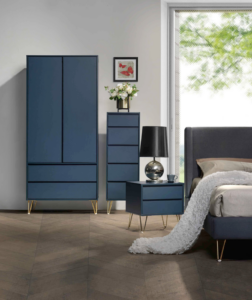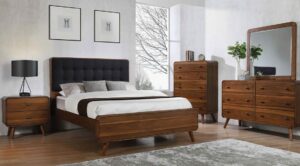The furniture industry in the United States is currently experiencing an oversupply of inventory. Many retailers are struggling to move excess stock in 2023. Retailers who would normally carry a standard 12-16 weeks of inventory now find themselves with nearly double that in their warehouses. This excess inventory is a result of several factors, including supply chain disruptions, the impact of the COVID-19 pandemic, and changing consumer preferences. A 2022 retail logistics report by the Wall Street Journal reported that retailers ordered wholesale goods in large quantities in response to demand that spiked during the pandemic, only to see that demand return to normal as the nation reopened. With demand for products fluctuating, many furniture retailers are now sitting on more inventory than they can easily sell.
This excess inventory is problematic for several reasons:
- It damages overall financial performance by increasing costs and decreasing profits.
- It ties up working capital, negatively impacting cash flow.
- Warehousing all that inventory can lead to increased storage costs, further eroding profits.
- Most potentially detrimental, unsold items can quickly become outdated and out of fashion, reducing their value and attractiveness to consumers.
As excess inventory accumulates, retailers may then be forced to discount products to move them, leading to a race to the bottom and diminishing the perceived value of their brand.
Creative strategies can minimize costs and maximize profits in today’s increasingly competitive market. Retailers must be agile and proactive in their approach to managing excess inventory, leveraging a wide range of strategies to engage customers, increase foot traffic, and differentiate themselves from competitors.
Here are some ideas to help you from the team at Shoptelligence:
Analyze Inventory Data
Maximizing sales in the face of excess inventory begins with the first crucial step of analyzing their inventory data. By examining this data, retailers can gain valuable insights into product performance, customer preferences, and market trends. Regularly review your inventory data to identify patterns in product performance. This can help you understand which products are selling well and which products are not, allowing you to adjust your marketing and sales strategies accordingly. It will also identify which products are most profitable, helping you make more informed decisions about which products to promote or discount.
Offer Discounts and Bundles
You can maximize sales by offering bundles and discounts even if you have excess stock. First, use data analysis to identify slow-moving items and create targeted marketing campaigns to promote them. Then you can:
- Create suites of furniture such as living room or bedroom sets to encourage customers to purchase multiple items at once. Buy-one-get-one, dollar or percent-off savings, and other offers can be especially effective when the promotion is applied to slower-moving items, encouraging customers to purchase these items alongside more popular products.
- Create a sense of urgency with limited time offers. These increase the likelihood that customers will feel spurred to action, as they won’t want to feel like they’re missing out on a good deal.
- Implement data-based dynamic pricing strategies to move excess inventory. If a particular product is not selling well and there is excess inventory, you might offer a temporary discount to incentivize customers to purchase the product. On the other hand, if a product is selling well and inventory is low, you can increase the price to maximize profits.
Personalize Sales Approaches
There was a time when furniture retailers were able to succeed with a one-size-fits-all approach. A customer would come to your brick-and-mortar store, walk around to view available options, make a purchase, and head home to await delivery. Those days are gone. Today’s consumers expect to be able to shop when and where it’s convenient, making stops in-store and online as they travel the path to purchase. Not only do they expect retailers to meet them anywhere and everywhere on their omnichannel journey, they also expect personalized interactions at every step of the way.
“Understanding the consumer is critical in understanding how to stock and accurately forecast demand. Gather consumer data and use these insights to drive your omnichannel strategy and align your marketing spend to meet the consumer where they are and promote maximum inventory turns.”
-Manal Ilayan, VP of Sales and Marketing
Every time a shopper visits your website, they are sharing critical information about their tastes, preferences, and budget. By partnering with Shoptelligence, you can use that information to make clients feel seen and valued, improving customer engagement, increasing customer satisfaction, and driving sales of excess inventory. Shoptelligence is a unique tool that helps retailers use that data to offer targeted recommendations that delight shoppers and inspire them to action in-store and online. Easily installed on your existing website, Shoptelligence delivers proven results. Stores typically see a return on their investment in 60 days or less, enjoying an average 42% increase in average order size, 33% increase in average order value, and 6X increase in time spent on site.
Take Full Advantage of All Channels
Expanding your reach is a key strategy to maximize sales in a high inventory environment. Make it easy for customers to purchase that excess inventory both in-store and online. Be sure to take steps to integrate your channels so that, no matter where a shopper engages with your brand, you meet them where they are and guide them to where they want to go. It’s common for customers to begin the shopping process on your website, then come in to the store to see, touch, and feel items in person. StyLeads by Shoptelligence bridges the gap between channels, gathering customer data at your website and making it available to associates in the store. With no more than a customer’s name or email address, associates can learn all that they need to know to provide high-quality, low-pressure service. They can educate and inform, making sure that shoppers find the items they’re searching for while simultaneously pointing out the overstocked items that you most want to sell.
Let customers know what you have to offer on social media and in personalized emails that reflect their style. Less than half of all retailers take advantage of email personalization, yet personalization leads to increased revenue, impulse purchases, and customer loyalty. Automating client emails empowers the customer, allowing them to drive the communication. Open rates go up and cart abandonment rates go down as emails are delivered based on client actions, delivering content and merchandising relevant to where they are on their shopping journey. Even better, automation will cut down on the time it takes to create and send these emails, saving you on staff costs.
Streamline Inventory Management
Streamlining inventory management is critical to maximizing furniture sales in a high inventory situation. Optimize the flow of inventory throughout your supply chain, from procurement to warehousing to sales. This includes managing inventory levels, tracking inventory movement, and managing your supply chain to ensure that inventory is available when and where it’s needed. You can accomplish this with inventory management software that tracks inventory levels in real-time, sets reorder points, and automates the ordering processes. This will ensure that you have the right inventory levels at all times, reducing the risk of overstocking and waste. Examine procurement processes to find flaws in your systems and identify areas for improving transportation and logistics. By streamlining the supply chain, retailers can reduce lead times, improve product availability, and increase customer satisfaction.
Retailers like you are growing ticket size, increasing customer lifetime value, and boosting revenue in the face of excess inventory with Shoptelligence’s proven AI-powered omnichannel platform. Let’s talk about what Shoptelligence can do for your business. Schedule a product tour today.






